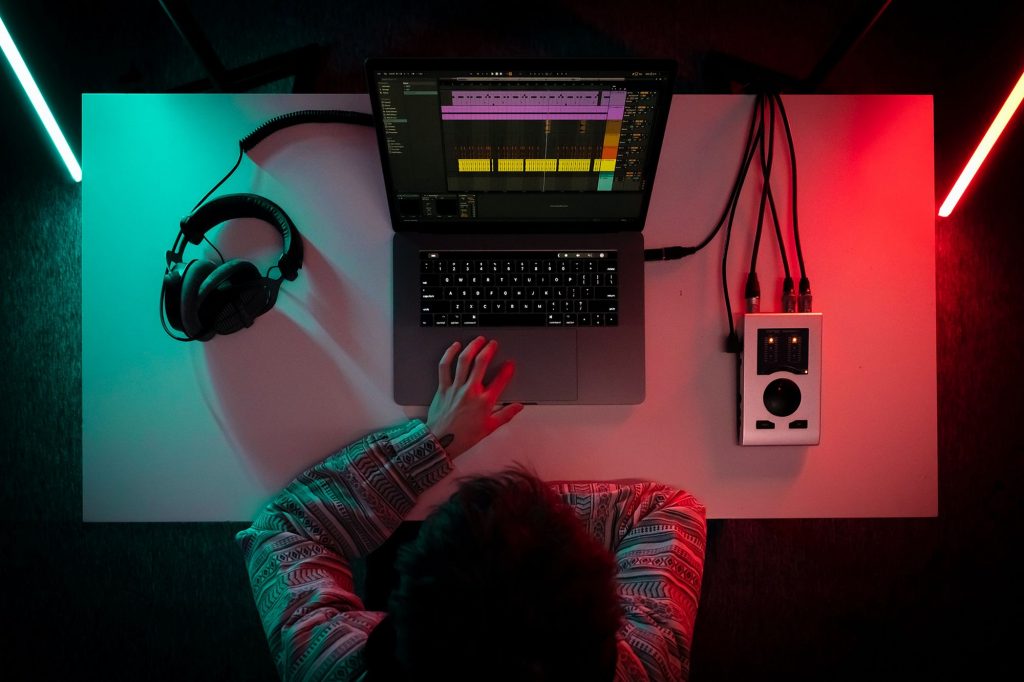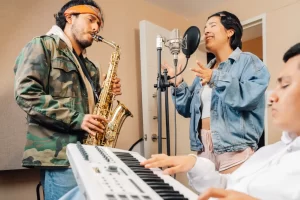You’ve got a melody stuck in your head that you know will be fire with the right beat, you have to get it recorded, how do you do it? You could go old-school and break out the tape recorder and dust off the piano – by the way, bonus points if you still have blank cassettes – or you could get with the current century, hop onto your computer and capture it on your digital audio workstation allowing you to fully mix your creation to your creativity’s content.
Maybe you’re a musician who is new to digital audio workstations, DAWs, and have no idea which of the dozens of sponsored search engine ad results to choose from. Or you’re a longtime user of DAWs and are looking to upgrade to something more up-to-date, feature rich and currently supported. In either case, picking the best music production software for you can be a difficult decision, a bit like picking the right instrument – you want to make sure you have all the right tools to let your mind go free and create.
Luckily it’s 2022 and in our modern deluge of technology the number of digital audio workstations has skyrocketed meaning there’s now more tools for artists like you to choose from than ever! This gives you the flexibility to decide what will be the best music making software for you and your situation.
Let’s go over some of the things to keep in mind when deciding and then review some of the most popular digital audio workstations!
Things to Consider
To choose the best music making software there’s a couple things to consider first. The type of music or environment you want to work in is important. Will you be recording live instruments in a professional recording studio or will you be sampling and remixing tracks to DJ for live EDM shows? Some software like Ableton Live 11 is specialized for live performances while others like Avid Pro Tools 12 are more suited for late nights in the studio.
Will you be working on a Mac or PC? It may be easy to think that surely these two ecosystems would have overlapped by now, but unfortunately no. There’s still some great software limited to only Mac’s. Apple’s Logic Pro and its little brother, GarageBand are two great DAWs only available on iOS with the latter being one of the best free options available.
Your personal budget needs to be considered too. While there are some free DAWs that are great to learn on like GarageBand, they are often limited in functionality and in the long-run can dampen your creative potential.
There’s nothing wrong with learning on a free platform, but putting an investment into a decent DAW can pay off in the long run with expanded features, better hardware compatibility, and continuous support and updates.
Consider how far you want to take your musical career as well. An investment into a mid-priced DAW like FL Studio can make a lot of sense for some artists, but if for example you want to work in a professional studio one day, paying the upfront price for an industry standard platform like Avid Pro Tools and spending the time to learn it can pay off massively in the future.
Ableton Live 11
Ableton Live 11 is probably one of the most popular DAWs on this list, starting its life off more than 20 years ago as a device for looping sampled audio, perfect for live performances. Decades later, Ableton Live 11 is available at three price points: $99, $449 and $749.
As its name suggests, Live’s features make it more like an instrument, giving you a very stable platform capable of putting on live performances, especially popular in EDM and hip-hop music. Live is able to adjust its tempo according to a live audio input channel with Tempo Following, as well as save and recall macros in snapshots for seamless deployment.
As multi-track recording software, Live is a powerhouse allowing unlimited (with the Standard or Suite versions) MIDI and audio tracks, automation with up to 16 macros per effect rack and precise control over midi note’s pitch, tone, intonation, even vibrato, with support for MIDI polyphonic expression, MPE.
Live 11 now also includes comping and multi-track simultaneous editing, a very handy time saving ability as well as tons of plugins for effects like hybrid reverb, a spectral resonator, pitch-shifters with delays, on and on.
Ableton Live 11 is a great fit for you if you are an EDM musician that will make great use of the libraries of virtual instruments, plugins and effects. Features like MPE will give you precise control over MIDI instruments.
FL Studio
FruityLoops, no not the cereal, FL Studio by Image-Line is a very popular, powerful and newbie friendly digital audio workstation. After version 20, FL Studio now also works natively on 64-bit macOS. FL Studio is available at four price points: $99, $199, $299, and $499.
FL Studio lives up to its original name FruityLoops by being a powerful DAW with loop-based composition tools. Because of this it still has a reputation for being great for electronic music and not so great for live music – even the $99 “Fruity” version (yes, that’s it’s name) of FL Studio does not allow you to record input audio.
However, that doesn’t mean FL Studio is limited to just electronic music since the versions that do allow for input recording allow all the same features you would expect from other digital audio workstations.
FL Studio has some of the best VSTs available on it, making it second to none when it comes to creating audio from the ground up. VST is a Virtual Studio Technology that emulates hardware synthesizers, samplers and other devices and can turn a single computer into an entire studio of instruments.
To help your creative process FL Studio has an interface called the step sequencer, a visually intuitive user interface that lets you activate samples or other sounds in sequence. This easy to navigate layout is partially why FL Studio is so popular with new users.
Image-Line FL Studio is perfect for you if you are a beginner looking to get into electronic music or you want a great platform for electronic music production. Powerful VST’s and an intuitive interface make it one of the best music production software available for electronic music.
Avid Pro Tools 12
Avid Pro Tools 12 is the industry standard for digital audio workstations – walk into a professional recording studio and you will probably see Pro Tools 12 on the screens. With that quality comes an equally high price, Pro Tools 12 is available for $199 for a one year subscription or about $32 per month.
As you might expect from its reputation, learning to use Pro Tools 12 is an investment all on its own, with entire classes dedicated to just this piece of software. Don’t let that discourage you though since learning to use this now could get your foot in the industry’s door later.
Pro Tools lets you do it all, sound design and sound recording, editing, mixing and mastering with up to 768 audio tracks, or 256 simultaneous voices. It even lets you edit video in 4k 120 fps with support for 130 audio channels of Dolby Atmos through Dolby Atmos Bridge. Because of this it is the preferred software in professional music, movies and broadcasts.
Pro Tools even saves you from one of the worst mistakes any musician can make – forgetting to hit record. Even if you forget to record, Pro Tools can still capture audio so your performance won’t be missed. Though Pro Tools can be controlled fully digitally, Avid offers physical control surfaces for those who prefer it
If you’re looking for a serious tool that will probably still be the industry standard for years to come, look no further than Avid Pro Tools 12. Works on Mac and PC systems.
Apple Logic Pro X
Apple’s Logic Pro X is a powerful, Mac only digital audio workstation that can’t be ignored especially with its recent price reduction, from $499 to just $199.
Logic Pro X was already a fully-featured DAW but Apple has recently updated live mixing and looping features similar to FL Studio and Ableton Live. Logic now has Live Loops, which is an interface for audio samples or loops arranged in a cell and they recently added a feature called Step Sequencer, with an interface inspired by drum machines that makes the programming of beats and melodies more intuitive.
As a piece of software, Logic Pro X is packed full of plug-ins, synths, features and controls. It is so fully featured that it competes with industry standard programs like Avid Pro Tools 12. It can also integrate with GarageBand making the step from one to the other seamless.
With an iOS app called Logic Remote, your iPhone or iPad can become a multi-touch MIDI controller, launcher and Live Loops Grid Viewer with touch control for samples and loops for Logic Pro. This is a great feature for those looking to cut down on hardware costs or be minimalist.
While yes, Apple is playing catch-up again with features, it is still a welcome addition for EDM producers, especially those who use Apple products. Apple’s Logic Pro X is perfect for you if you are a Mac user, especially if you started out in GarageBand, and are looking for industry-leading performance. Logic Pro X is great for live music multitrack recording with up to 255 input channels.
Steinberg Cubase
Starting its life off as a MIDI sequencer, Cubase literally invented the technology that gives us virtual studio technology, VSTs. While it is in a market full of other fully capable DAWs, Cubase is still a great piece of software. Cubase is available at three price points: $99, $329, and $579 and can be run on a maximum of three computers.
As you might imagine since Cubase invented VST’s, Cubase comes packed with incorporated VST’s and a massive out-of-the-box sound library. It has support for unlimited audio tracks as well as MIDI tracks, effects which are aimed at the audio-loop, EDM artist.
Some of the great tools available in Cubase include VariAudio for pitch correction and editing, Scale Assistant which lets you make changes while staying within the appropriate key signature. It has an Audio to MIDI ability that Logic Pro also has, allowing you to turn music into a series of events on the Chord Track for easy editing.
Cubase is great if you are already familiar with the platform or do not mind a steep learning curve.
GarageBand
There’s no way we could write this list without at least mentioning GarageBand – okay we mentioned it a few times. GarageBand comes in at the fabulous price of: free! Sort of, you have to own a Mac computer first.
However for the millions of people who have access to a Mac, there is no better and more accessible digital audio workstation than GarageBand. When it comes to price-to-performance, nothing beats the performance of “free”!
Okay but seriously, Microsoft Paint is free and we don’t use it for serious artwork. However, what started off as a relatively simplistic audio editing program has become a very capable digital audio workstation that integrates into Apple’s Logic Pro X. It can even use the same Logic Remote app as Logic Pro, turning your iPhone or iPad into a multitouch input device or even showing the timeline grid.
Because of its accessibility and simplicity, GarageBand is perfect for beginners and even younger students to learn on. The effects and plugins it includes are not spectacular, but they are serviceable and allow you to create a lot. If you are learning to play the piano or guitar GarageBand even has built-in lessons to help teach you.
Navigation and manipulation of tracks within GarageBand is usually clear and intuitive, so if you are easily overwhelmed by the cluttered user interfaces of other DAWs, this is a great place to start.
Since GarageBand is free, there are some microtransactions associated if you want to have access to more loops or plugins for example, which are available through the app store.
In summary GarageBand is perfect for beginners, being simple and easy to learn on while still offering some great functions as a fully operational digital audio workstation.
In conclusion
There are plenty of options to choose from when it comes to producing your music. In this short article, we wanted to cover what those options look like so you can decide how to proceed with producing your music.
At Novecore, we help musicians distribute their music on all major platforms, including Spotify, Apple Music, SoundCloud, and others. Once your music release is ready, sign up for a free Novecore account and we’ll help you distribute and monetize your music. In the meantime, make sure to check out our blog where we talk about the best ways to make, distribute and promote your music.




